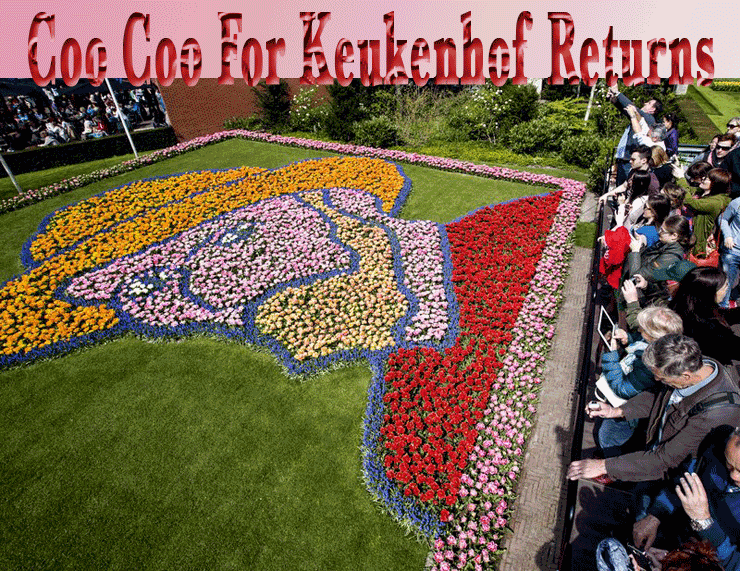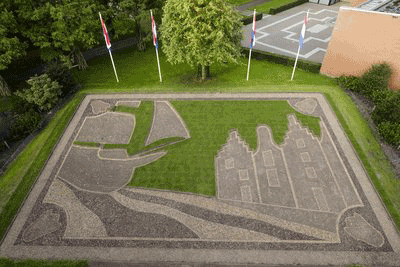
Snow continues
to visit us in the northeast, but our trustiest weatherman,
the groundhog, has forecast an early spring, so we should
soon be amid a flurry of flowers rather than snowflakes.
The promise of warm weather couldn’t come at a
better time, too, with the month of love already a week
underway and the desire for fresh-cut flowers only growing.
 Last year around this time, we talked
about the glorious flower show that is Holland’s
Keukenhof. With 800 varieties of tulips and more than
7 million bulbs planted, Keukenhof is easily the best
flower show on earth. Each year Keukenhof celebrates
its native Netherlands with a themed mosaic featuring
hundreds of thousands of tulips—2015 celebrated
famed local artist Vincent Van Gogh on the 125th anniversary
of his death. FlyingTypers ran photos of the
garden after it was planted, but frankly the gorgeous
painter’s palette of tulips may have been a bit
underwhelming, given that it was February and the tulips
were not yet in flower. This year, we bring you the
photo of the fully bloomed Vincent Van Gogh, who came
to life in gorgeous hues of fuchsia, crimson, apricot,
butterscotch, and eggplant. And of course, we look forward
to when this year’s themed garden explodes into
color, although once again all we can show you a is
freshly-planted patch of mud—you’ll have
to use your imagination until everything bursts forth
again in the coming spring. Last year around this time, we talked
about the glorious flower show that is Holland’s
Keukenhof. With 800 varieties of tulips and more than
7 million bulbs planted, Keukenhof is easily the best
flower show on earth. Each year Keukenhof celebrates
its native Netherlands with a themed mosaic featuring
hundreds of thousands of tulips—2015 celebrated
famed local artist Vincent Van Gogh on the 125th anniversary
of his death. FlyingTypers ran photos of the
garden after it was planted, but frankly the gorgeous
painter’s palette of tulips may have been a bit
underwhelming, given that it was February and the tulips
were not yet in flower. This year, we bring you the
photo of the fully bloomed Vincent Van Gogh, who came
to life in gorgeous hues of fuchsia, crimson, apricot,
butterscotch, and eggplant. And of course, we look forward
to when this year’s themed garden explodes into
color, although once again all we can show you a is
freshly-planted patch of mud—you’ll have
to use your imagination until everything bursts forth
again in the coming spring.
This year’s theme is the Golden
Age—quite a propos and a bit meta, given the role
tulips played in fostering the Dutch Golden Age. The
mosaic features the Netherlands’ famous skyline
of tall, thin, bottlenecked buildings on one side, an
audience for the giant, cargo-laden ship approaching
from the opposite side. Fittingly, four tulips frame
the mosaic.
 The
Dutch Golden Age, which spanned the 17th century, changed
the history of the world forever. A confluence of factors
shaped this magical period—the Thirty Year’s
War ended with the Netherland’s declaration of
sovereignty; immigrant artisans and intellectuals fleeing
religious prosecution fell upon the tolerant Dutch Republic
in droves, resulting in an explosion of art, science,
and literature; windmill power was a cheap energy source;
the Dutch East India trading company was formed and
became the first multinational corporation, maintaining
a monopoly on Asia. The Dutch were maritime experts—both
as seamen and as mapmakers, so this period of prosperity
was easily ensured. And of course, we mustn’t
forget ‘Tulipomania,’ about which we referred
in last year’s Keukenhof coverage. The
Dutch Golden Age, which spanned the 17th century, changed
the history of the world forever. A confluence of factors
shaped this magical period—the Thirty Year’s
War ended with the Netherland’s declaration of
sovereignty; immigrant artisans and intellectuals fleeing
religious prosecution fell upon the tolerant Dutch Republic
in droves, resulting in an explosion of art, science,
and literature; windmill power was a cheap energy source;
the Dutch East India trading company was formed and
became the first multinational corporation, maintaining
a monopoly on Asia. The Dutch were maritime experts—both
as seamen and as mapmakers, so this period of prosperity
was easily ensured. And of course, we mustn’t
forget ‘Tulipomania,’ about which we referred
in last year’s Keukenhof coverage.
If one were to use their imagination,
it would not be hard to see Keukenhof’s Golden
Age tulip celebration in full color—the duotoned
blue of a roiling sea ushering forth a loaded ship with
wind-blown sails, multicolored sentry buildings waiting
patiently at the shore, and the bright, bold tulip demigods
peering from the corners as in old, classical paintings.
Flossie Arend |





